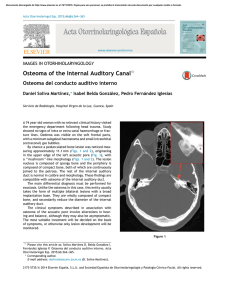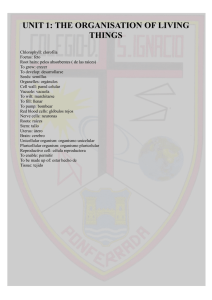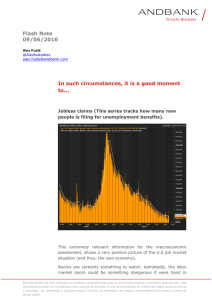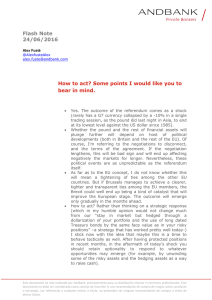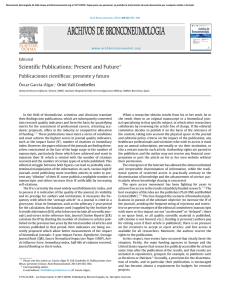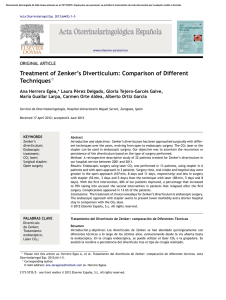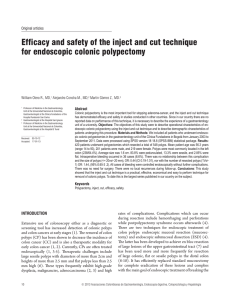Descargar PDF
Anuncio
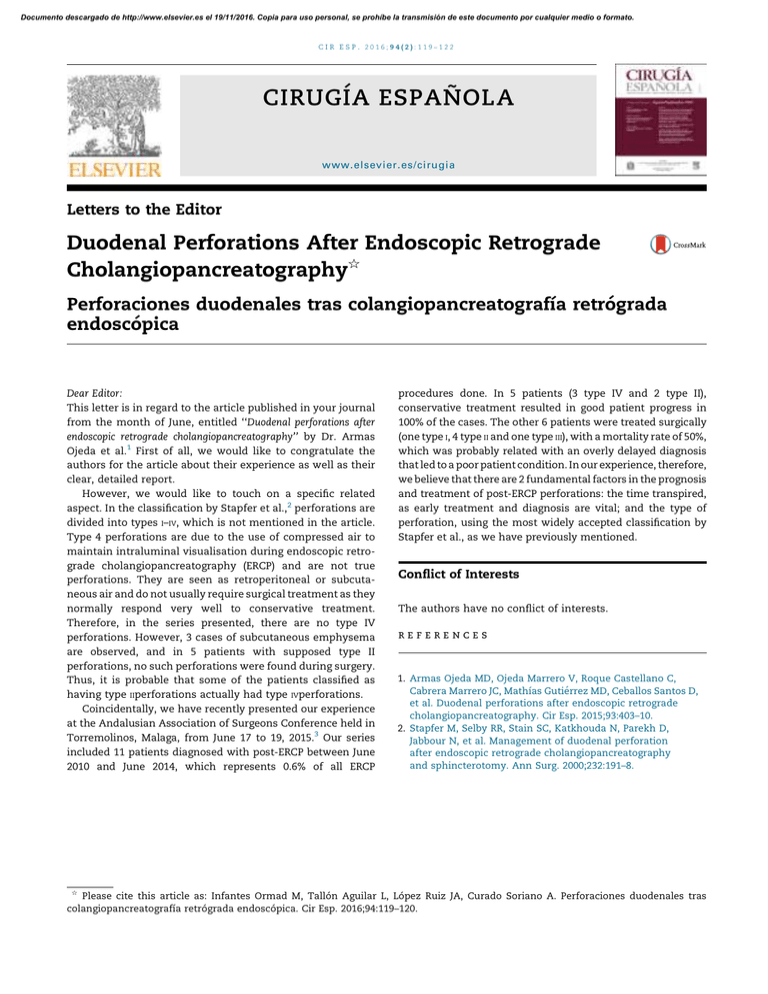
Documento descargado de http://www.elsevier.es el 19/11/2016. Copia para uso personal, se prohíbe la transmisión de este documento por cualquier medio o formato. cir esp. 2016;94(2):119–122 CIRUGÍA ESPAÑOLA www.elsevier.es/cirugia Letters to the Editor Duodenal Perforations After Endoscopic Retrograde Cholangiopancreatography§ Perforaciones duodenales tras colangiopancreatografı́a retrógrada endoscópica Dear Editor: This letter is in regard to the article published in your journal from the month of June, entitled ‘‘Duodenal perforations after endoscopic retrograde cholangiopancreatography’’ by Dr. Armas Ojeda et al.1 First of all, we would like to congratulate the authors for the article about their experience as well as their clear, detailed report. However, we would like to touch on a specific related aspect. In the classification by Stapfer et al.,2 perforations are divided into types I–IV, which is not mentioned in the article. Type 4 perforations are due to the use of compressed air to maintain intraluminal visualisation during endoscopic retrograde cholangiopancreatography (ERCP) and are not true perforations. They are seen as retroperitoneal or subcutaneous air and do not usually require surgical treatment as they normally respond very well to conservative treatment. Therefore, in the series presented, there are no type IV perforations. However, 3 cases of subcutaneous emphysema are observed, and in 5 patients with supposed type II perforations, no such perforations were found during surgery. Thus, it is probable that some of the patients classified as having type IIperforations actually had type IVperforations. Coincidentally, we have recently presented our experience at the Andalusian Association of Surgeons Conference held in Torremolinos, Malaga, from June 17 to 19, 2015.3 Our series included 11 patients diagnosed with post-ERCP between June 2010 and June 2014, which represents 0.6% of all ERCP § procedures done. In 5 patients (3 type IV and 2 type II), conservative treatment resulted in good patient progress in 100% of the cases. The other 6 patients were treated surgically (one type I, 4 type II and one type III), with a mortality rate of 50%, which was probably related with an overly delayed diagnosis that led to a poor patient condition. In our experience, therefore, we believe that there are 2 fundamental factors in the prognosis and treatment of post-ERCP perforations: the time transpired, as early treatment and diagnosis are vital; and the type of perforation, using the most widely accepted classification by Stapfer et al., as we have previously mentioned. Conflict of Interests The authors have no conflict of interests. references 1. Armas Ojeda MD, Ojeda Marrero V, Roque Castellano C, Cabrera Marrero JC, Mathı́as Gutiérrez MD, Ceballos Santos D, et al. Duodenal perforations after endoscopic retrograde cholangiopancreatography. Cir Esp. 2015;93:403–10. 2. Stapfer M, Selby RR, Stain SC, Katkhouda N, Parekh D, Jabbour N, et al. Management of duodenal perforation after endoscopic retrograde cholangiopancreatography and sphincterotomy. Ann Surg. 2000;232:191–8. Please cite this article as: Infantes Ormad M, Tallón Aguilar L, López Ruiz JA, Curado Soriano A. Perforaciones duodenales tras colangiopancreatografı́a retrógrada endoscópica. Cir Esp. 2016;94:119–120. Documento descargado de http://www.elsevier.es el 19/11/2016. Copia para uso personal, se prohíbe la transmisión de este documento por cualquier medio o formato. 120 cir esp. 2016;94(2):119–122 3. Infantes Ormad M, López Ruiz JA, Tallón Aguilar L, Curado Soriano A, López Pérez J, Oliva Mompeán F, et al. Perforación post-CPRE: nuestra experiencia. XIV Congreso de la Asociación Andaluza de Cirujanos (Torremolinos, Málaga, 17–19 junio 2015). Marina Infantes Ormad, Luis Tallón Aguilar*, José A. López Ruiz, Antonio Curado Soriano *Corresponding author. E-mail address: [email protected] (L. Tallón Aguilar). 2173-5077/ # 2015 AEC. Published by Elsevier España, S.L.U. All rights reserved. Unidad de Cirugı́a de Urgencias, Hospital Virgen Macarena, Sevilla, Spain Regarding the Article ‘‘Mixed Choledochal Cyst (Type I and II) Associated With a Malformation of the Pancreatobiliary Junction. A Case Report and Review of the Literature’’. Can We Improve the Diagnosis?§ A propósito del artı́culo ‘‘Quiste de colédoco mixto (tipo I y II) asociado a malformación de la unión pancreatobiliar. Descripción de un caso y revisión de la literatura’’. Podemos mejorar el diagnóstico? ? Dear Editor: We have read with interest the article by Dr. Zacarı́as-Ezzat et al., published in CIRUGÍA ESPAÑOLA.1 The article describes a case of choledochal cyst and reviews the related literature. We feel it is necessary to make some comments on this article. In the case reported, after a computed tomography (CT) scan of the abdomen showed dilatation of the intraand extrahepatic bile duct up to the ampullary region, surgical treatment was carried out. The procedure included diverticulectomy, but afterwards a second surgery was required for the necessary bile duct resection. We consider it a very illustrative case that demonstrates once more the need for a correct diagnosis of patients with jaundice to avoid unnecessary or inappropriate surgery. As reported by several studies,1,2 when there is cystic dilatation of the bile duct suspected by CT, the diagnosis of choledochal cyst, its type and any possible associated pancreaticobiliary junction anomaly can be confirmed by magnetic resonance cholangiopancreatography (MRCP), which has a high sensitivity (90%–100%) and specificity (73%–100%). Thus, the management described in the article does not seem to be the most adequate. Furthermore, the authors do not describe the role of MRCP in this situation. Even though MRCP is not available at all hospitals, we believe that this diagnostic method should be mentioned as it is optimal for avoiding invasive procedures. We would also like to emphasise that the indication for bile duct resection is considered the gold standard treatment for all type I cysts, and exeresis of the cyst is reserved for type II.3,4 Types III to V cysts require a personalised approach, as we have described in our experience with 18 cases published in CIRUGÍA ESPAÑOLA in 2008.4 Last of all, as the article reports including a review of the literature, we find that both the review and bibliographic references lack the articles we have mentioned,2–4 two of which are the most complete reviews published, and our own experience is one of the most extensive national reports. Funding The authors have received no funding for this paper. Conflict of Interests The authors have no conflict of interests to declare. § Please cite this article as: Lladó L, Ramos E. A propósito del artı́culo «Quiste de colédoco mixto (tipo I y II) asociado a malformación de la unión pancreatobiliar. Descripción de un caso y revisión de la literatura». Podemos mejorar el diagnóstico? Cir Esp. 2016;94:120–121. ?

